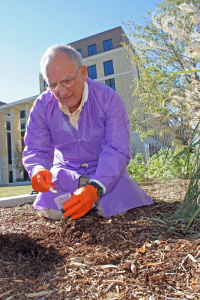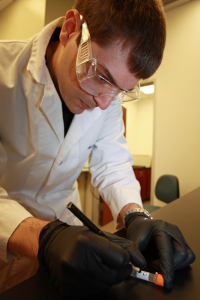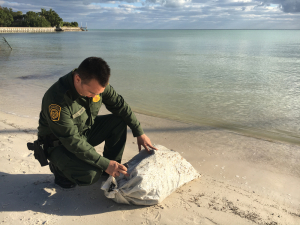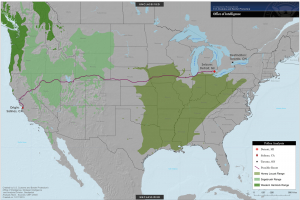The power of pollen: how CBP is at the forefront of using pollen as a new forensic tool
28 June 2016
By Marcy Mason, a writer who covers trade for US Customs and Border ProtectionIn June 2015, when the partially decomposed body of an unidentified little girl, known as Baby Doe, was found in a trash bag on a beach on Deer Island in Boston Harbour, the National Center for Missing & Exploited Children in the United States (US) contacted US Customs and Border Protection’s (CBP’s) forensic pollen expert, Andrew Laurence, for help.
Laurence, one of the world’s foremost forensic palynologists and one of only two such experts in the US, has helped the Center identify the geographical origins of other children in the past. He found more than 30 different types of pollen grains on the Baby Doe evidence sent to him. Most were common to the Northeast. “There was a lot of pine, oak, birch, and a little bit of spruce,” he said.
But then, there were the unexpected types of pollen that he found. Baby Doe’s clothing and blankets contained two types of Cedrus or cedar pollen grains. One of the species in the sample was cedar of Lebanon. “It didn’t grow in New England until the early 1900s, when the Arnold Arboretum of Harvard University in Boston imported a specific variety of the trees that now grow throughout the area,” said Laurence. But it was the second species of cedar that clinched it. “The only place I could find the second type of cedar was the Arnold Arboretum, so I knew that Baby Doe was from the Boston area,” he said.
In less than two weeks, Laurence delivered the results. “It was a very helpful tool,” said Trooper Daniel Herman, the detective from the Massachusetts State Police homicide division investigating the case. “We had hundreds of leads and calls coming in from all over the country. The pollen analysis indicated that the child had spent a significant part of her life in the Boston area. So it was encouraging news for us. It helped us narrow down our search and focus the effort we put into leads.”
Although pollen analysis has been used for forensic purposes for several decades, it is a new technique for US law enforcement. As the only US federal agency with a forensic palynologist on staff, CBP is leading the US law enforcement community in using this new forensic tool for investigations and intelligence.
Unknown field
Forensic palynology, not a widely known field, is defined as using pollen and spores to solve criminal or civil legal issues. Essentially, there are two types of forensic palynology. The first is when pollen is used to investigate crimes. The second is when pollen is used to determine the geographical location or ‘geolocation’ of items or people.

“Every location in the world has a unique pollen print – just like a fingerprint,” said Vaughn Bryant, a Professor of Anthropology and the Director of the Palynology Laboratory at Texas A&M University in College Station, Texas, who is regarded as ‘the father of forensic palynology’ in the US. Similarly, every plant has its own unique pollen grain. “There are about 300,000 species of plants in the world. Each one produces a unique type of pollen,” said Bryant.
One of the reasons that pollen is so well-suited to forensic investigations is because pollen is everywhere. “Any object that is exposed to the environment is collecting pollen,” said Laurence, one of Bryant’s former students and his protégé. “We can analyse pollen to reconstruct the environment of where that object came from or the different places that it’s been. For example, we can trace the route of a truck as it travels through different ecological and vegetation zones, because as the truck travels, it’s collecting different types of pollen grains,” he said.
“We also can analyse clothing and tell where someone has been. Pollen can hang onto clothing for quite some time even after repeated washings,” said Laurence. “So even if you wash your clothes several times, the pollen will still be there from the day you bought the clothes. It becomes embedded in the fabric.”
Pollen is also indoors. “When people are going in and out of a building, they’re collecting pollen,” said Laurence. “They bring the pollen in on their clothes and it transfers into the air inside the building. There can be up to 10,000 pollen grains per cubic metre of air, roughly the space inside a home refrigerator,” said Laurence.
Moreover, pollen is extremely resilient. It stays intact and doesn’t lose its physical structure. “Under the right preservation conditions, pollen is virtually indestructible,” said Laurence. “Pollen grains could be 20 million years old, more than 200 million years old – before the age of dinosaurs, or even go back as far as when the first plant life appeared on earth 450 million years ago.”
However, forensic pollen analysis isn’t ideal for every type of situation. “If you have a sample that has been exposed to the local environment for a couple of days, chances are it’s so heavily contaminated with local pollen that it would be difficult to determine where it actually came from,” said Laurence.
Historical roots
The earliest reported case of forensic pollen analysis successfully being used as criminal evidence occurred in Austria in 1959. Pollen found on the soles of a suspect’s muddy boots was linked to the site where a man had disappeared while vacationing along the Danube River near Vienna. During the 1960s and 1970s, there were other European criminal cases that used pollen as a forensic tool to link suspects to events or crime scenes.
In America, forensic palynology took root in 1975, when Bryant, a botanist who had studied pollen at archaeological sites, started to analyse pollen for forensic purposes. The US Department of Agriculture (USDA) tapped his expertise for a loan subsidy programme to help US honey farmers. Bryant tested honey samples, identifying the pollen content, to determine if the honey was produced domestically – one of the requirements of participating in the programme.
Unbeknownst to Bryant, it was a huge undertaking. “I had absolutely no idea what I was getting into,” said Bryant. “I had never looked at honey before and thought it would be relatively easy. What I did not realize is that just in North America alone, not counting the rest of the world, there are probably somewhere close to 90,000 to 100,000 different plant species that could potentially be used for pollen or nectar.”
After five years of identifying pollen, Bryant became an expert. But then the price of honey on the world market soared and the USDA ended its honey subsidy programme. In 1980, Bryant was not able to find anyone in the US who wanted to hire him for his forensic palynology skill. “No one at that time was doing forensic palynology anywhere in the world except New Zealand,” said Bryant.
In the 1990s, interest in using forensic palynology reemerged in countries such as the United Kingdom, but the US lagged behind. It was not until after the 11 September 2001 terrorist attacks that pollen was used as a forensic tool. One of the US intelligence agencies contacted Bryant about using his forensic palynology skill for security purposes. “I was looking at samples that had been collected by the intelligence community from places where terrorists were active. There were samples of everything from rugs to cars to people to dwellings to weapons – even bombs,” said Bryant.
Then, just as his work with the intelligence agency was winding down, CBP reached out to Bryant. “We had intelligence gaps related to the movement of narcotics. We wanted to know more specifically where the drugs were coming from, how they were grown, and how the cartels were operating so that we could strengthen our interdiction efforts,” said Patricia Coleman, Acting Director of CBP’s Office of Intelligence.
Surprising connection
One of the first samples that Bryant tested was from an 8,000-pound (3,629 kg) marijuana seizure taken from a warehouse in San Diego, California in November 2011.The warehouse was connected to a drug tunnel that ran beneath the US-Mexico border. Two weeks later an 8,646-pound (3,922 kg) marijuana seizure was made at a ranch in Starr County, Texas.
“The two seizures were in two different states, more than a 1,000 miles (1,609 km) apart, but the forensic pollen analysis revealed that there was a shared nexus where the marijuana was cultivated or packaged,” said Steven Goldfarb, a Watch Commander in the Counter Network Division at CBP’s National Targeting Center, who is currently assigned to the Drug Enforcement Administration’s (DEA’s) Special Operations Division. “From an intelligence perspective, we concluded that the same drug trafficking organization was responsible for the growth site and the distribution of both marijuana shipments.”
CBP also made another eye-opening discovery. “The presumption was that the marijuana moving through Texas was coming from the cartels that controlled the states south of Texas. But that’s not what we were seeing,” said Coleman. “The pollen testing showed that the drug shipments seized in Texas were coming from Sonora, which is south of Arizona.”

A few months later, Bryant did pollen testing on another batch of shipments. This time with Laurence’s help. Between March and May of 2012, CBP officers and Border Patrol agents made numerous marijuana seizures on the southern border near El Paso, Texas. Further inland, state and local law enforcement agencies also made several marijuana seizures that involved heavy farm equipment used to smuggle the drugs.
“We thought there was some connection among these shipments because the drug seizures were coming through the same channels,” said Goldfarb. “Through forensic pollen analysis, we discovered that all of the marijuana had a specific pollen type, a ‘key marker’ that stands out. It’s a pollen that generally points to a very precise location. In this case, the plant was sagebrush,” he said.
Although there are more than a 100 species of sagebrush in the US, in Mexico, there is only one known species, which only grows in a few isolated locations. “We were able to narrow down very precisely a particular area of Mexico where the marijuana was cultivated,” said Goldfarb. “This tied into a bigger case involving a specific drug trafficking organization in Mexico that was under investigation. The pollen analysis linked this organization to the marijuana seizures in Texas,” he said.
CBP shared information with the Mexican government, and in June 2012, Mexican authorities raided a farm outside of the city of Chihuahua, where they seized 400 kg of marijuana and 13 sacks of marijuana seed weighing almost 300 kg.
More than marijuana
For more than a year, CBP’s Office of Intelligence used pollen to track the flow of marijuana shipments. “Then it became bigger. We weren’t looking at just marijuana anymore,” said Coleman. “We were looking at other narcotics such as cocaine, heroin, and crystal methamphetamine. Basically, we were using science to tell a story, to piece it altogether, to find out who was involved, how the drugs were made, where they came from, and what routes they travelled.”
By this point, it had also become apparent that CBP needed to hire a full-time forensic palynologist. “Once we started getting results, things took off,” said Coleman. “We couldn’t keep up with the demand. We literally had a backlog.” Bryant recommended Laurence who shared his passion for forensic palynology and had proven to be gifted in the field. Laurence now works full-time at CBP’s Houston laboratory.
One of the cocaine cases that Laurence worked on was a drug bust in Detroit, Michigan in November 2013. The cocaine, which was not destined for the US market, was seized from a truck before it exited the country to Canada. The truck’s manifest indicated that the truck had travelled from Salinas, California. “We wanted to verify that,” said Laurence. The pollen revealed that the truck did originate in Salinas, drove up the coast to San Francisco, and then turned east, travelling through Nevada, Utah, Wyoming, Nebraska, Iowa, and Illinois until it eventually arrived in Detroit, where the cocaine was seized.
“It was a curious route,” said Goldfarb. “The question is – why would you take your shipment all the way to Detroit when you can go straight up to Canada through the state of Washington? It was evident that there was a drug deal going on, and this gave us an investigative lead. Just like on the Mexican side of the border, there are different cartels in Canada that control specific regions,” said Goldfarb. “If we give that information to the highway patrol, they could occasionally do some enforcement and stop the movement of cocaine through the US.”
Another unexpected finding from the pollen analysis involved panga fishing boats. While panga boats are legitimate fishing vessels, drug cartels use the boats to move narcotics up the West Coast. “Initially the panga boats would leave Mexico from the Baja California peninsula and sail up to the San Diego coastal area,” said Coleman. “But in 2012, we started to see a lot of panga movement further north up the Pacific Coast, and it was becoming a problem.”
CBP’s Office of Intelligence wanted to get a better idea of how the cartels were operating, so pollen was tested on abandoned boats. “We analysed the interior of the boats, wiping them down the sides as well as inside the engines and the engine covers,” said Laurence. “The boats contained lots of pine, lots of oak, and a few spruce or fir pollen grains. In Mexico, fir trees only grow in the highest elevations of the mountains.”
“What we derived from this in an intelligence sense is that they were loading the boats discreetly at the higher elevations and then driving them to the water to launch them,” said Coleman. “Once again, this finding enabled us to give information to the Mexican government to do enforcement.”
Washed ashore
Pollen analysis also has helped CBP trace the routes of marijuana and cocaine bundles that wash up onshore along the coasts of Florida and Texas. As early as 2011, the Border Patrol in the Miami Sector started to see a steady increase in drug bundles washing-up in the Florida Keys.

“We had over 40 wash-ups in fiscal year 2015,” said J.R. Shook, a Border Patrol agent in the Miami Sector’s Intelligence Unit. “From the trends we’re seeing during the first quarter of 2016, we expect that number to rise.” Compared to the same period last year, Border Patrol statistics for the state of Florida show nine times the number of marijuana bundle wash-ups.
When bundles are found, the Border Patrol sends samples to Laurence for testing. “The majority of the wash-ups are bundles of marijuana from the Caribbean, especially Jamaica,” said Coleman. “What clued us in was the samples we examined are loaded with fern spores, more than would be typical of an area where ferns grow. There are only a few areas that have that many ferns and one of them is Fern Gully, a winding, scenic stretch of road in Jamaica,” said Coleman.
“Prior to the pollen testing, we had no idea where the narcotics were originating from, so when a bundle would land on the beach, Homeland Security Investigations would just seize it and there wasn’t an investigation,” said Shook. “No smuggler was caught, no information was captured; the drugs were just destroyed,” he said. “With pollen analysis, we’re now able to pinpoint where the narcotics originated and the probable routes and methods used to smuggle them into the country. That, in turn, helps us counter the threat.”
Before long, the pollen testing was expanded to gather intelligence on other aspects of CBP’s mission including seized weapons, currency, and even identifying travel routes and places of origin of criminals, potential terrorists, and other persons of interest.
“We’re looking to apply forensic pollen analysis to matters of national security,” said Coleman. “We’re looking at travel routes of people who are travelling to the US. These are people who have already been identified by CBP systems that are used to determine risk associated with travel,” she said. “Pollen can trace a person back to a certain location. In light of foreign fighters and concerns about individuals coming to the US, this is an avenue for us to explore, to find out if people have been in conflict zones.”
Processing pollen
The pollen analysis process is arduous and labour intensive. “Pollen processing itself is a very long process. There are a lot of chemical steps as well as physically washing the samples,” said Laurence. “Normally, it takes four to six hours to process a sample if everything goes well. That includes vacuuming the sample to extract the pollen.”

But there are often complications. For example, if a cocaine sample is not completely pure, the impurities need to be dissolved. “It takes time to figure out what those impurities are and what can dissolve them,” said Laurence. Other times there could be a lot of sediment in the sample that traps the pollen. “This adds a lot of extra steps and a lot more time,” he said.
After a sample is processed, then Laurence identifies the pollen with a microscope. “I sit down and count the pollen grains. How long that takes depends on how many grains are in the sample, what the sample is, where it came from, and what types of pollen grains are there,” he said. “While I’m counting, I’m identifying and if there are lots of different pollen grains, it could take a long time to determine what everything is as well as matching it against known pollen types. If I’m looking at pollen from regions where there isn’t a lot of information, it could take even longer.”
One of Laurence’s biggest challenges is knowing what grows in various places around the world. In some countries, like the US, extensive pollen mapping studies have been done. In other places, such as the Middle East, South America, and Mexico, information is scant. “It’s either because of political reasons or some places are just very difficult to get to like the Amazon,” he said. Laurence and Bryant also rely on reference collections, databases, books, and other forensic palynologists, however, there are few.
“There are only a handful of forensic palynologists in the world, maybe five,” said Jen O’Keefe, the past President of AASP – The Palynological Society, an international association based in Houston, Texas. “It’s very hard to identify people with the right skill set to do this. You have to be extremely exacting and careful in the laboratory. You also need an incredible memory for shapes and sizes, and for where you last saw something. Plus you need to have the patience and stamina for long hours at the microscope.”
Forensic value
“It’s amazing that pollen, a small microscopic particle, could have such a great impact on criminal investigations,” said Coleman. “Sometimes the findings that come out of pollen analysis are things we would never even venture to think about. It’s like a new discovery, a new piece of information that supports existing intelligence or counters what we know,” she said. “It gives us irrefutable, scientific evidence that allows us to rethink how we look at the processes, the procedures, and the tactics of the criminal enterprise, but perhaps what’s most exciting are the endless possibilities of pollen as a forensic tool.”
More information
www.cbp.gov
